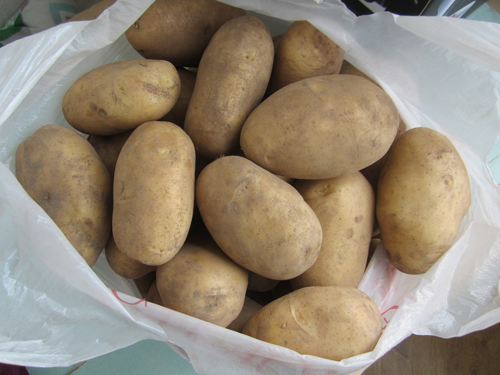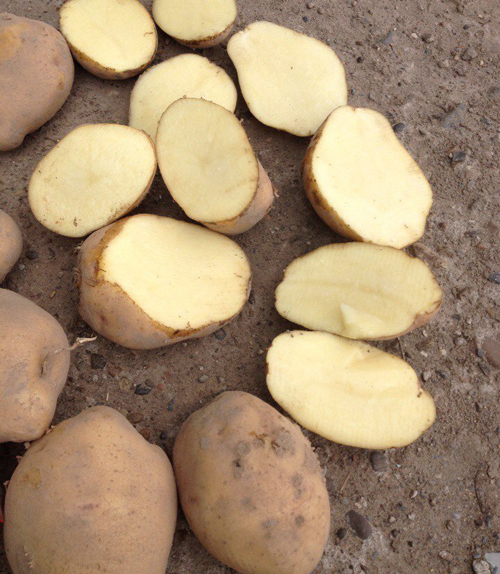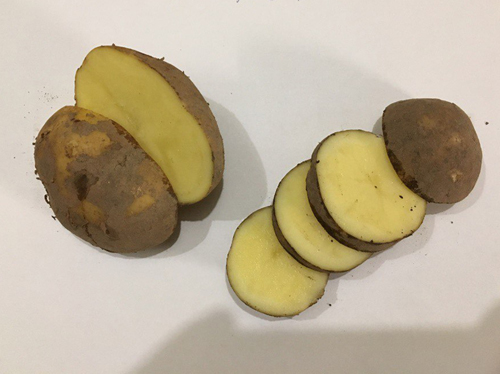Potato variety Kolobok
Gingerbread man is a mid-season potato variety (Solanum tuberosum) for table use. Bred by employees of the FSBSI "All-Russian Research Institute of Potato Economy named after A.G. Lorkha "in the Moscow region. In 2005, 5 years after filing an application for admission, he was included in the state register of breeding achievements of the Russian Federation in the Central Region. Suitable for the production of potato products. Suitable for mechanical harvesting and transportation over long distances, recommended for industrial cultivation.

The period from full sprouting to ripening is 85 - 100 days.
The plant is tall or medium, intermediate type, semi-erect or erect. Leaves are simple, medium to large, intermediate type, matte light green in color. The edges of the leaf plate are slightly wavy, the veins are well pronounced. The flowers are very large and white in color.
The root system of Kolobok is well developed, 15-18 tubers weighing 95-120, and sometimes up to 140 grams, develop under one plant. The starch content in them is 11.4-14%. Tubers are round, smooth. The peel is slightly reticulate, dense, rough to the touch, yellow in color. The pulp on the cut is light yellow in color, does not darken during cutting and cooking. The eyes are not large, in small numbers, the depth of their occurrence is average.
The marketable yield per hectare of land is 124-227 centners, which is 6-82 centners / ha more than the indicators of the Bronnitsky variety. The maximum amount of the crop was harvested in the Moscow region - 256 c / ha, which is at the level of the potato standard Lugovskoy... The yield of marketable tubers is quite high - 87−97%.

The taste is very good. The pulp is medium-sized, slightly mealy, not watery. When boiled, tubers crack, but at the same time retain their shape. Best of all, the Kolobok is suitable for making mashed potatoes, cooking in a peeled or "uniform" form, as well as for baking, deep-frying and dressing soups. As noted earlier, the pulp does not darken during heat treatment, which makes it look very attractive when finished. The variety is actively used on an industrial scale for the production of various potato products, such as chips, frozen semi-finished products and vegetable mixtures, freeze-dried puree, as well as starch, potato flour, flakes and grits. The originator states that the tubers are ideal for evacuation.
The advantages of this variety include excellent keeping quality - 98%. When laying for the winter, tubers retain their consumer qualities and good presentation for a long time. However, to achieve this result, it is necessary to observe the correct storage conditions.
The Kolobok variety is picky about the composition of soils and climatic conditions of growth, prefers light fertile soils. By the way, that is why it is widespread in the Central and Central Black Earth region of the country, and in other regions it is a little less common. However, the plants are relatively unpretentious, respond well to watering and feeding, while they have average resistance to heat and drought. But nevertheless, it should be noted that they perceive a prolonged absence of moisture rather painfully. In care, potatoes do not require special attention, but basic agricultural techniques are necessary to get a good harvest. Below is a small list of growing guidelines.

- Potatoes are planted in May, when the soil warms up to + 8 ° C.
- Before planting, the most suitable tubers of approximately equal size should be selected and treated against diseases and pests. Growth stimulants can also be used.
- The depth of the planting holes should be about 10 cm, the distance between them should be 30−35 cm.It is advisable to make the row spacing wider, about 70 cm.
- During the growing season, it is necessary to apply two or three times the introduction of mineral and organic fertilizing into the soil. Be careful with nitrogen fertilizers - with their increased amount, the green mass of the Kolobok begins to grow to the detriment of the tubers.
- Do not forget about timely watering, loosening, hilling, weeding and preventive treatment against diseases and pests.
- Maintain crop rotation at the site. The best predecessors are green manures, legumes, cucumber, cabbage, beets, peppers, onions and garlic.
This potato has good resistance to cancer and Alternaria. Weakly susceptible to common scab and rhizoctonia, most often affected by the golden cyst-forming potato nematode. As for late blight, according to the All-Russian Research Institute of Phytopathology, the tops are less susceptible to disease, while the tubers are very susceptible to it. According to gardeners, plants are often affected by the Colorado potato beetle, less often by the wireworm.
Kolobok is one of the most successful varieties of Russian selection. By the way, "VNII Potato Economy named after A.G. Lorkha "in the popular representation has long been a quality mark. The list of advantages of this variety is impressive: high and, most importantly, stable yield, good taste, resistance to heat and drought, excellent keeping quality and marketability of tubers, suitability for industrial cultivation and mechanical harvesting, as well as transportation. It is customary to refer to disadvantages as too dense peel, which complicates the cleaning of tubers, but this can also be attributed to the advantages - during harvesting and transportation, the crop does not lose its excellent presentation. Of the minuses, one can also note the exactingness of soil fertility, as well as susceptibility to certain diseases and pests, but these problems are solved by using simple agronomic techniques. Summing up, we can say that choosing this potato will be definitely the right decision!
The following companies are officially engaged in Kolobok cultivation: LLC Agrocenter Korenevo and SPK Agrofirma Elite Potato in the Moscow region; Individual entrepreneur Head of the farm Stebakov Vladimir Ivanovich, in the Oryol region.








